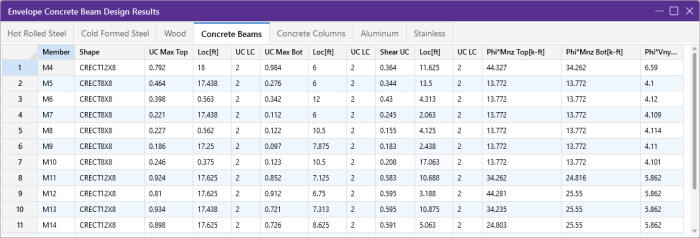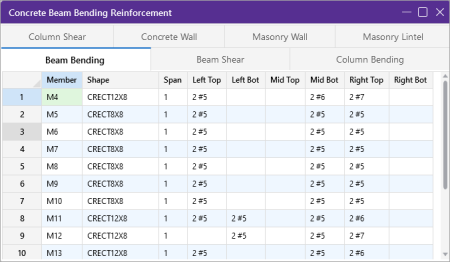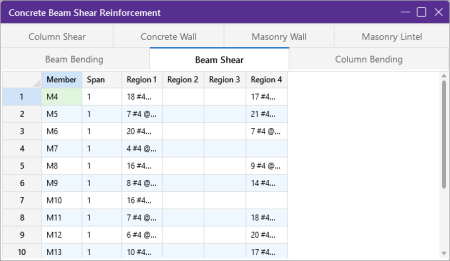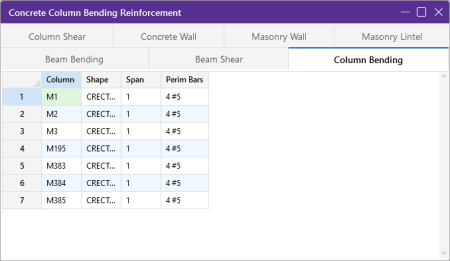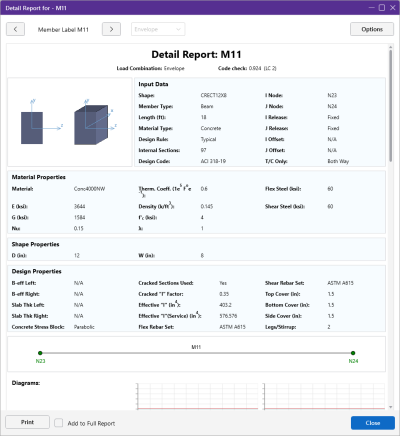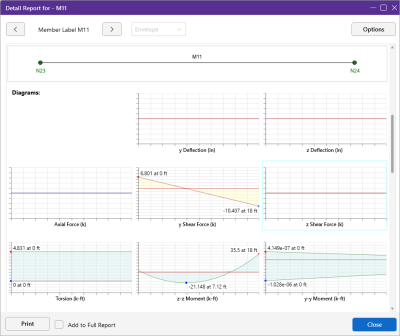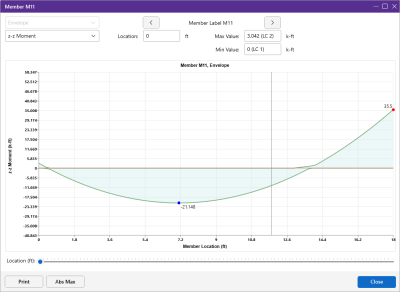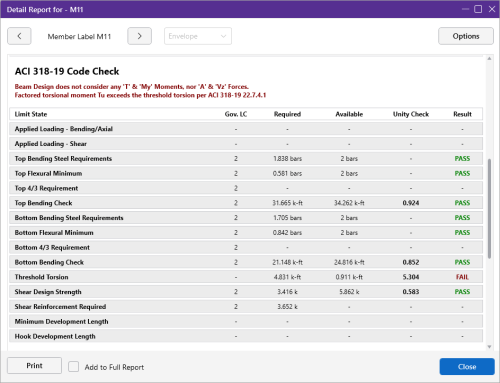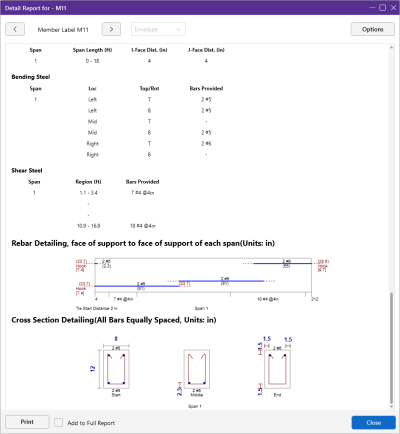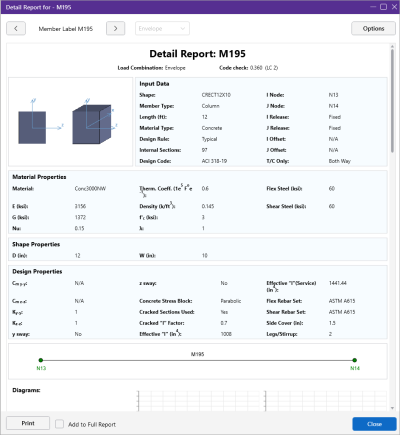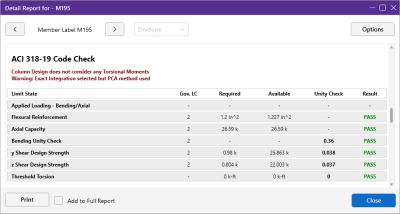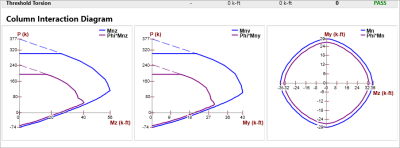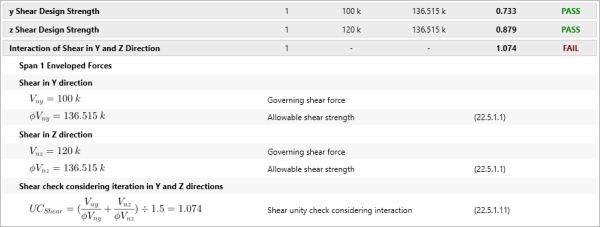Concrete Member - Design Results
Access the Code Check spreadsheet
by selecting the Results tab  Envelope (or LC) button
Envelope (or LC) button  Code Check. Alternatively, on the Results toolbar you can select Code Check.
Code Check. Alternatively, on the Results toolbar you can select Code Check.
For beam flexural design, the required bars are
based on the envelope moment diagrams.
Beam Results
Beam results are shown in the
Design Results Spreadsheet
The Design Results Spreadsheet shows the governing maximum code check for the top and bottom of the beam for all spans.
Click on image to enlarge it
These top and bottom code checks, UC Max Top and UC Max Bot, are based on the top/bottom moment capacities and maximum top/bottom moment. Currently the moment capacity is based only on the tension steel (NO compression steel is considered in the capacity calculation). The governing maximum shear check for all spans, Shear UC, is also shown. The capacities shown are only for the governing section. Capacities for each span, as well as beam reinforcement detailing diagrams, may be viewed on the Detail Report.
Beam Bending Reinforcement Spreadsheet
The Beam Bending Reinforcement Spreadsheet records the top and bottom flexural reinforcement steel required for the left, middle, and right locations of each beam. This spreadsheet may be accessed by
selecting Members ![]() Concrete Reinforcing on the Results Menu and the results are listed on the Beam Bending tab.
Concrete Reinforcing on the Results Menu and the results are listed on the Beam Bending tab.
Click on image to enlarge it
The Member column lists the beam label.
The Shape column displays the
beam size.
The Span column displays the span number corresponding to the reinforcement sections listed. Span '1' is the span beginning at the "start" of the beam and subsequent spans are numbered '2', '3', '4', and so forth moving from the "start" to the "end" of the beam.
The program assumes that the moment diagrams for all beam spans have two or fewer points of inflection. Therefore, each span is broken into Left, Middle, and Right Reinforcement Sections for flexural steel layout. Each section is further broken into Top and Bottom Reinforcement Sections. Note that a beam may have only two or even one reinforcement section. In this case, the other reinforcement sections would be left blank in this spreadsheet.
The Left Top, Left Bot, Mid Top, Mid Bot, Right Top, and Right Bot entries record the number and size of flexural reinforcement bars that are required in each of the six Reinforcement Sections. The first number indicates the number of parallel reinforcement bars in that section. The second number, preceded by the '#' sign, indicates the size of reinforcement bars used.
- Only reinforcement bars selected by the program are listed in this spreadsheet. If a custom rebar layout is used for a particular beam, all six reinforcement section entries will report "CUSTOM" as a reminder that the user applied a custom rebar layout.
- Longitudinal reinforcement bars are assumed to be in a single layer at the top and/or bottom of the member.
- Longitudinal reinforcement bars for the left and right sides of adjacent spans have been "smoothed" such that the larger steel area is used for both sides.
Beam Shear Reinforcement Spreadsheet
The Beam Shear Reinforcement Spreadsheet records the shear reinforcement ties required in
each shear region of each beam. This spreadsheet may be accessed by
selecting Members ![]() Concrete Reinforcing on the Results Menu and the results are listed on the Beam Shear tab.
Concrete Reinforcing on the Results Menu and the results are listed on the Beam Shear tab.
Click on image to enlarge it
The Member column lists the beam label.
The Span column displays the span number corresponding to the shear regions listed. Span '1' is the span beginning at the "start" of the beam and subsequent spans are numbered '2', '3', '4', and so forth moving from the "start" to the "end" of the beam.
Each beam's shear reinforcement layout is broken into either two or four Shear Reinforcement Regions. The user can control whether the program uses '2' or '4' regions from the Concrete tab of the Model Settings Dialog. The program will try to group the required shear ties/stirrups into two or four regions and will allow for a middle region to have no shear reinforcement if the shear force is lower than that for which the code requires shear reinforcement.
The Region 1, Region 2, Region 3, and Region 4 entries record the number, size, and spacing of shear reinforcement ties/stirrups that are required in each of the Reinforcement Regions. The first number of each entry indicates the total number of ties/stirrups that are required in that region of the beam span. The second number, proceeded by the '#' sign, indicates the size of reinforcement bars used. The third number, proceeded by the "@" symbol, indicates the spacing of the ties/stirrups in that region of the beam span.
- If '2' shear regions are selected on the Rebar tab of the Model Settings Dialog, the Region 2 and Region 3 entries in this spreadsheet will be left blank.
- The concrete code checks are only performed at the sections where the internal forces are calculated. The number of internal force calculations is based on the setting in the Model Settings dialog. Normally, this is acceptable for design and analysis. However, it is possible for the design locations (face of support for moment and "d" from the face of support for shear) to be located far enough away from the nearest internal force location that it could affect the code check results. If this happens, it may be advisable to use a larger number of internal sections. Or, the user may be forced to calculate the maximum Vu and Mu themselves.
Column Results
Column results are shown in the three following
spreadsheets:
Design Results Spreadsheet
The Design Results Spreadsheet shows the governing maximum code check for the column for all spans.
Click on image to enlarge it
The governing maximum shear check for all spans is also shown. The governing load combination for the governing code check is shown because the column capacity is based upon the actual moments and axial forces for that load combination. The capacities shown are only for the governing section. Capacities for each span, as well as column reinforcement detailing diagrams, may be viewed on the Detail Report.
The moving load results are enveloped and the governing load combination and step location is shown for each result value under the "UC LC" column. The first number is the load combination, the second is the step number: (load combination - step number). See Moving Loads to learn more.
Column Bending Reinforcement Spreadsheet
The Column Bending Reinforcement Spreadsheet shows the perimeter
flexural reinforcement steel required in each span of each column. This spreadsheet may be accessed by
selecting Members ![]() Concrete Reinforcing on the Results Menu and the results are listed on the Column Bending tab.
Concrete Reinforcing on the Results Menu and the results are listed on the Column Bending tab.
Click on image to enlarge it
The Column field displays the column label.
The Shape column displays the physical column or lift size. When no adequate member could be found from the available shapes, this field will display the text “not designed”. Consider re-framing, relaxing the design or deflection requirements (see Design Optimization), or adding more shapes to the available Redesign List (see Appendix A – Redesign Lists).
The Span column displays the span number corresponding to the perimeter reinforcement listed. Span '1' is the span beginning at the
The Perim Bars column records the number and size of perimeter longitudinal reinforcing bars. The first number indicates the total number of longitudinal bars in that span. The second number, preceded by the '#' sign, indicates the size of the reinforcement bars used.
- Only reinforcement bars selected by the program are listed in this spreadsheet. If a custom rebar layout is used for a particular column, the Perim Bars entry will be left blank.
- Longitudinal reinforcement bars are assumed to be uniformly arranged around the perimeter of the column for both rectangular and round column sections.
- A minimum of 6 bars will be used in round column sections.
- Longitudinal reinforcement bars for the bottom and top sides of adjacent spans have been "smoothed" such that the larger steel area is used for both sides.
Column Shear Reinforcement Spreadsheet
The Column Shear Reinforcement Spreadsheet shows the shear reinforcement ties required in each shear region of each column. This spreadsheet may be accessed by
selecting Members ![]() Concrete Reinforcing on the Results Menu and the results are listed on the Column Shear tab.
Concrete Reinforcing on the Results Menu and the results are listed on the Column Shear tab.
Click on image to enlarge it
The Column field displays the column label.
The Span column displays the span number corresponding to the shear regions listed. Span '1' is the span beginning at the
Each column's shear reinforcement layout is broken into either two or four Shear Reinforcement Regions. The user can control whether the program uses '2' or '4' regions from the Concrete tab of the Model Settings dialog. The program will try to group the required shear ties into 2 or 4 regions. Unlike beams, columns cannot have a zero shear steel region. Note also that columns in tension receive NO shear capacity from the concrete.
The Region 1, Region 2, Region 3, and Region 4 entries record the number, size, and spacing of shear reinforcement ties/stirrups that are required in each of the Reinforcement Regions. The first number of each entry indicates the total number of ties/stirrups that are required in that region of the column span. The second number, proceeded by the '#' sign, indicates the size of reinforcement bars used. The third number, proceeded by the "@" symbol, indicates the spacing of the ties/stirrups in that region of the column span.
Concrete Detail Reports
The Concrete Detail Reports allow you to see the
overall force
Detail reports for concrete
 New Floor Plan button will allow you to take a snapshot of the current detail report you are viewing so that it can be added to a report. View the Printing topic for more information.
New Floor Plan button will allow you to take a snapshot of the current detail report you are viewing so that it can be added to a report. View the Printing topic for more information. Beam Detail Reports
The image below is the first portion of a detail
report for a concrete beam
Click on image to enlarge it
You can tell the Member Type by looking at the
black title in the upper left corner next to the red member label.
This title will always show the member type (Beam
The Member Information in the text above the force
diagrams shows basic member information as well as the Concrete Stress
Block type used in the solution
The next section of the detail report contains the Member Force Diagrams. The diagrams shown are envelope diagrams of all solved load combinations. Any Unused Force Warnings or critical Design Warnings will be shown directly below the force diagrams in the detail report.
Click on image to enlarge it
Click on image to enlarge it
Each enlarged diagram will also have a slider bar at the bottom of the window for checking forces at all locations along the member. There is also an Abs Max button that will jump the slider bar to the absolute maximum value in the diagram. Note that once an enlarged diagram is opened, diagrams for other forces may be accessed via the pull down menu on the left.
The Code Check Information directly below the force diagrams is a summary of the governing checks for bending and shear, their location, and the section capacities at those locations. Separate bending checks for the most critical top and most critical bottom condition are given. Gov Muz Top and Gov Muz Bot represent the governing ultimate moment in the top and bottom of the beam respectively. Gov Vuy represents the governing ultimate shear along the local y axis of the beam.
The values phi*Mnz Top and phi*Mnz Bot represent the nominal moment strength in the top and bottom of the beam respectively, reduced by the appropriate Strength Reduction Factor, Phi, as indicated in the code. Likewise, the value phi*Vuy represents the nominal shear strength in the beam, reduced by the appropriate Phi Factor.
There is also general concrete, reinforcement,
and bar cover information about the section provided which you would need
if you were doing a hand check. Concrete Type (Normal Weight vs
Light Weight) is automatically determined from the Concrete Weight density
per the ACI code. λ is taken from the Materials spreadsheet. The E_Concrete value shown here is either the
value entered on the
The Span
Information gives the start and end of each
span centerline within the member, as well as the distance from the
The next portion of the detail report shown below contains detailed information for the placement of the Bending Steel and the Bending Span Results for each span. The bending capacity for the governing section in each span is shown as Mnz, the nominal moment strength. Rho Min and Rho Max are the minimum and maximum required reinforcement ratios at each location. These values are based on the minimum and maximum reinforcing requirements for flexural members as described in ACI 318-14 Sections 9.6.1 and 21.2.2/9.3.3.1 respectively (ACI 318-11 Sections 10.5.1 and 10.3.3/10.3.5 respectively). Rho is the ratio of reinforcement corresponding to the area of steel provided at each location, As Prvd. The As Req value is the area of steel required at each location.
Click on image to enlarge it
The next portion of the detail report, shown above, contains detailed information for the placement of the Shear Steel and the Shear Span Results for each span. Shear results are shown by region within each span. The number of regions used is a function of the shear diagram, with the maximum number of regions being taken from the Shear Regions setting on the Concrete tab of the Model Settings Dialog. The number, size, and spacing of reinforcing bars is given for each region. Also indicated is the nominal shear strength, Vn, in each region. The portion of the nominal shear strength provided by the concrete and the steel, Vc and Vs respectively, is given for each region. The area of steel required, As Reqd, and the area of steel provided, As Prvd, are also given for each shear region and are reported as 'area of steel per unit dimension', i.e. in2/in or mm2/mm.
It should be noted that the values for Mn and Vn given in this section of the detail report are the UNREDUCED nominal capacities of the member at each span/region. The actual design capacities would be obtained by multiplying these values by their respective Phi Factors indicated in the code.
The last section of the detail report shows the Beam Reinforcement Detailing Diagrams. The Rebar Detailing portion of the report shows elevation views of the beam complete with top and bottom flexural reinforcement indicated for the left, middle, and right portions of each span. The number and size of bars required in each section is indicated on the top middle of each drawn bar. The required length of each bar is indicated on the bottom middle of each drawn bar in parenthesis. Development lengths are shown in parenthesis at one end of each bar and is represented by a dashed line. For bars at the ends of the beam, hooked development lengths are given in addition to the straight development lengths and are shown in brackets.
The values shown at the bottom corner of each span indicate the distance from the start of the beam to the face of a support. Flexural bars at the ends of the beam are measured beginning at the face of the support and bars at intermediate supports are measured to the center of the support.
The number, size, and spacing of shear reinforcement is also indicated below each span in the corresponding shear region. Each shear region is indicated by vertical lines at the bottom of the beam.
Click on image to enlarge it
The Cross Section Detailing portion of the report shows cross sectional views for the start, middle, and end of each beam span. The number and size of flexural bars for each cross section are shown as well as the orientation of the shear ties/stirrups. The clear cover to each stirrup for the top and sides is shown. The overall beam dimensions for each span are indicated on the 'Start' cross section.
Column Detail Reports
The image below is the first portion of a detail report for a concrete column member showing the member information, warnings, force diagrams, code checks, and span information. As can be seen, the concrete column results are very similar to the beam results with just a few additions and differences.
Click on image to enlarge it
Click on image to enlarge it
You can tell the Member Type by looking at the black title in the upper left corner next to the red member label. This title will always show the member type (Beam, Column, HBrace, VBrace). If the member type is "None", this title will be displayed as "Member".
The Member Information in the text above the force diagrams shows basic member information as well as the Concrete Stress Block type used in the solution, whether Cracked Sections were used for the nominal design, and the Cracked 'I' Factor that was used for that member. The Biaxial Bending Solution method that was used is also reported, and if applicable, the Parme Beta Factor.
The next section of the detail report contains the Member Force Diagrams. The diagrams shown are envelope diagrams of all solved load combinations.Any Unused Force Warnings or critical Design Warnings will be shown directly below the force diagrams in the detail report. An enlarged interactive member force diagram can be accessed by clicking on the desired diagram. For more information, see Beam Detail Reports.
The Code Check Information below the force diagrams is a summary of the governing checks for bending and shear, their location, and the section capacities at those locations. Gov Pu represents the governing ultimate axial load in the column. Gov Muy and Muz represent the governing ultimate moment about each local axis of the column. Gov Vuy and Vuz represent the governing ultimate shear along each local axis of the column.
There is also general concrete, reinforcement, and bar cover information about the section provided which are useful for hand calculation verification.Concrete Type (Normal Weight vs Light Weight) is automatically determined from the Concrete Weight density per the ACI code. The E_Concrete value shown here is either the value entered on the Concrete tab of the Materials Spreadsheet or is the calculated value based on the given f’c and weight density (if the 'E' value was left blank on the Materials Spreadsheet).

- When solving using the Exact Integration method, a worst-case combination of Pu, Muy, and Muz is determined. A straight line is essentially drawn between the origin of the interaction diagram, and this coordinate within the 3D interaction diagram. The bending check is taken as the length of that line, divided by the distance from the origin to the intersection of that line and the interaction diagram. For this reason the ratios (Pu/φPn), (Mu/φMn) are all equal to the bending check.
Click on image to enlarge it
The next portions of the detail report shown above contain the Column Interaction Diagrams for the column member and the Span Information.
A Column Interaction Diagram for uniaxial bending is shown for each axis of the column. These diagrams plot the unreduced nominal strengths P vs. M for the corresponding column local axis. If the column only has bending about one axis there will be only one interaction diagram shown.
For columns under biaxial bending there is also a diagram which plots the unreduced nominal moments strengths Mz vs. My at the governing ultimate axial load, P. The last diagram is for the biaxial bending condition where the exact integration method is used and shows the interaction surface plotted at the angle of applied load (Pu, Muy, Muz). This last diagram is only shown when the Exact Integration Method is used.
The Span Information section shows the length of each span and the distances from the centerline of each support to the face of each support.
This portion of the report shown above contains the sections pertaining to the axial, bending, and shear results as well as the longitudinal and shear reinforcement.
The Column Steel section indicates the longitudinal reinforcement in each span as well as the governing load combination and location. The ultimate axial load, Pu, and the ultimate moments, Muy and Muz, are also given for each span.
The Axial Span Results show the strength reduction factor, Phi_eff, used for each span. The axial capacities for each span are shown as Pn, the nominal axial strength, and Po, the nominal axial strength with zero eccentricity. The area of longitudinal reinforcement provided in the column is listed as As Prvd and the ratio of As Prvd to the gross cross sectional area of the column is listed as Rho Gross.
The Bending Span Results show the calculated eccentricities, ecc. y and ecc. z, due to the ultimate moment about each axis divided by the ultimate axial load. The neutral axis depth for bending about the local y-axis and z-axis are listed as NA y-y and NA z-z respectively. These neutral axis locations are always given with respect to the geometric center of the column. Also shown in this section are the unreduced nominal moment capacities, Mny and Mnz, for each span of the column. If the PCA Load Contour Method is used, Mnoy and Mnoz are given, representing the maximum allowable moment for uniaxial bending at the nominal axial strength, Pn (see Biaxial Bending of Columns). If the Exact Integration Method is used, these values will be left blank.
The Shear Steel section of the report shows each span of the column broken into one or more shear regions and the number, size, and spacing of shear stirrups required in each of those regions is given. The shear design for columns is the envelope of all the shears for both directions.
The y-Dir and z-Dir Shear Span Results show the nominal shear strength, Vny and Vnz, in each shear region of the column followed by the nominal shear strengths of the concrete, Vcy and Vcz, and the nominal shear strengths of the steel, Vsy and Vsz. The area of shear reinforcement required in each shear region of the column is shown as Asy Reqd and Asz Reqd. The area of shear reinforcement provided in each shear region of the column is shown as As Prvd. Shear demand and concrete capacity are shown for both directions, but only one design of shear ties is used. Thus the As_reqd may vary for each side, but the As_prvd will always be the same.
Click on image to enlarge it
- In the Code Check spreadsheet the direction (Dir) becomes “y,z” to indicate the governing load combination is considering shear interaction.
Click on image to enlarge it
Magnified Moments / Slenderness Effects

The Slender Bending Span Results give the ultimate moments for each axis amplified for the effects of member curvature, Mcy and Mcz. These values will be left blank for spans that do not meet the criteria for slender columns in the specific direction. Also shown in this section are the values KL/rfor the y and z-axis, followed by the equivalent moment correction factors Cm yy and Cm zz. The unbraced lengths of the column for each span and each direction, Lu yy and Lu zz, are given as well.
For Non-Sway frames, the assumption is that EI = 0.25*Ec*Ig. This is equivalent to setting Bdns to 0.6 in ACI 318-14 Equation 6.6.4.4.4a (ACI 318-11 Equation 10-15). For sway frame columns with a KL/r value greater than 22, the moment amplification is applied to the total moment rather than the "non-sway" portion of the moment.
Warning Log Messages will be produced when the following occurs:
- If the KL/r for the column exceeds 100 per Section 10.11.5 of ACI 318-05. Note this message only occurs for 2005 and older codes.
- If a slender member is classified as being part of a Sway frame, but a P-Delta analysis was NOT performed. For sway frames this P-Delta requirement applies anytime the slenderness ratio KL/r exceeds 22.
